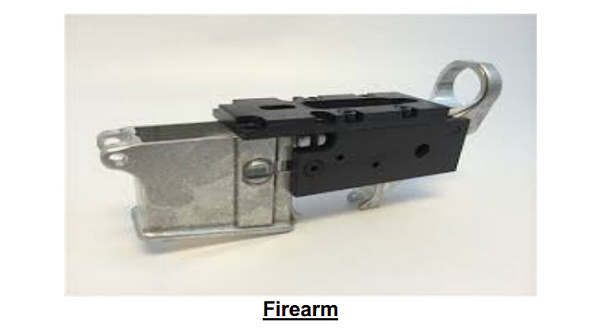

Federal Court: ATF Overstepped
Authority with "Final Rule",
Denies ATF Motion for "Clarification"


Images from ATF New Definition of Firearm in "Final Rule"
By Dean Weingarten. Oct 4, 2022
Article Source
On September 2, 2022, the United States District Court, Northern District of Texas, Fort Worth Division, issued an Opinion and Order granting a preliminary injunction, in part, on the ATF "Final Rule" which radically changed the decades long definition of what is a firearm in federal law. The opinion explains that ATF created the longstanding definition of what is a firearm in 1978. Now, over forty years later, they are updating and expanding the definition into new areas. From the opinion/order, p. 2-4:
In April 2022, ATF published a Final Rule changing, among other things,the 1978 definition of "frame or receiver." See Definition of "Frame or Receiver" and Identification of Firearms, 87 Fed. Reg. 24,652 (Apr. 26, 2022) (codified at 27 C.F.R. pts.447, 478, and 479(2022)). 1ATF split the phrase into two parts, assigning the term "frame" to handguns and the term "receiver" to any firearm other than a handgun, such as rifles and shotguns. See 27 C.F.R. §478.12(a)(1), (a)(2). ATF then defined the terms "frame" and "receiver" along the same lines as the 1978 rule, though with updated, more precise technical terminology.2 But ATF did not stop there.
Rather than merely updating the terminology,ATF decided to regulate partial frames and receivers. Under the new Final Rule, "[t]he terms 'frame'and 'receiver' shall include a partially complete, disassembled, or nonfunctional frame or receiver, including a frame or receiver parts kit, that is designed to or may readily be completed, assembled, restored, or otherwise converted to function as a frame or receiver."Id.§478.12(c). But "[t]he terms shall not include a forging, casting, printing, extrusion, unmachined body, or similar article that has not yet reached a stage of manufacture where it is clearly identifiable as an unfinished component part of a weapon (e.g., unformed block of metal, liquid polymer, or other raw material)." Id. When determining whether an object is a frame or receiver, the ATF Director is not limited to looking only at the object. "When issuing a classification, the Director may consider any associated templates, jigs, molds, equipment, tools, instructions, guides, or marketing materials that are sold, distributed, or possessed with the item or kit ...." Id.
The Final Rule also amends ATF's definition of "firearm" to include weapon parts kits.The ATF's new definition of "firearm," "shall include a weapon parts kit that is designed to or may readily be completed, assembled, restored, or otherwise converted to expel a projectile by the action of an explosive." Id.§478.11(definition of "firearm").
The Court found ATF exceeded their authority. From the opinion/order, p. 6:
1. The Final Rule exceeds ATF's statutory authority under the plain language of the Gun Control Act.
The Administrative Procedure Act requires courts to "hold unlawful and set aside agency action, findings, and conclusions found to be ... in excess of statutory jurisdiction, authority, or limitations." 5 U.S.C. §706(2)(C). Plaintiffs argue the Final Rule exceeds ATF's statutory authority under the Gun Control Act in two ways. First, Plaintiffs argue that the Final Rule expands ATF's authority over parts that may be "readily converted" into frames or receivers, when Congress limited ATF's authority to "frames or receivers" as such. Second, Plaintiffs argue that the Final Rule unlawfully treats weapon parts kits as firearms. Plaintiffs are likely to succeed on both claims.
On September 23, 2022, Blackhawk Manufacturing Group, doing business as 80 Percent Arms, filed a motion to intervene (to be included in the lawsuit). The motion is under consideration. The court has ordered the ATF to reply by October 7, 2022.
On September 26, 2022, the court denied the Goverment's motion for clarification, where the ATF wanted to complete a classification of one of the plaintiff's products. The Court ruled to do so would be in contravention of the injunction it placed in effect on September 2, 2022.
Texas is in the Fifth Circuit Court of Appeals. Another Court in Texas refused to issue a preliminary injunction.
In North Dakota, in the 8th Circuit Court of Appeals, Judge Peter D. Welte refused to grant a preliminary injunction in another case challenging the ATF "Final Rule".
A major contention is the wording of the 1968 Gun Control Act, which clearly differentiates weapons which "may be readily converted" and receivers, which does not include the "may be readily converted" language.
In addition, the inclusion of information, tooling, and jigs as part of what is defined as a firearm is new and a considerable expansion of governmental power.
In Delaware, Judge Maryellen Noreika has ruled the ability to make and possess homemade guns is protected by the Second Amendment.
The Supreme Court may eventually take a case on what power, if any, the ATF may legitimately have to regulate the private, non-commercial making of or sale of firearms, and what may be defined as a "firearm". The court action may take years.
©2022 by Dean Weingarten: Permission to share is granted when this notice and link are included.
![]()

























